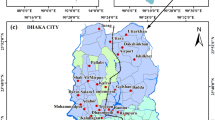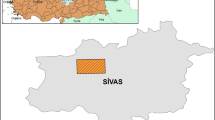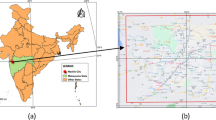Abstract
Urban land surface temperature (LST) is dependent on many factors, including land cover, building materials, urban density, and other human activities. The current study evaluated Baghdad's LST and urban heat island (UHI) changes during 1984–2020, one of the world's hottest capital cities. The study also examined the relationship between LST and various land use and land covers (LULC). The Landsat data (TM and OLI/TIRS) data were used to retrieve normalized difference vegetation index (NDVI) and normalized difference built-up index (NDBI). Results showed increases in LST in Baghdad between 1984 and 2020 due to increased urbanization, decreased green lands, and expansion of baren areas. The highest LST is associated with residential and barren areas, ranging from 46.7 to 52.7 °C, while lowest with water bodies and orchards areas, ranging between 25 and 30.4 °C. UHI effect appeared clearly in 2020 in different parts, particularly in suburban areas around Baghdad. Higher LST was observed in less vegetated areas and vice versa. The study revealed that the average maximum temperature in Baghdad increased from 40.2 °C in 1984 to 47 °C in 2020 or about 6.8 °C during 36 years. The NDVI showed a negative correlation and NDBI a positive correlation with LST. The results improved the understanding of urban LST's relation to LULC in developing an inclusive climate resilience policy and making Baghdad more sustainable to face the consequences of climate change.












Similar content being viewed by others
Data availability
Data can be provided upon request from the corresponding author.
References
Abouelmagd SAS (2020) The rehabilitation of slums and informal settlements in greater Cairo: applying a livelihood perspective to evaluate existing policy and implementation approaches
Al Qeisi S (2012) The city of Baghdad between the reality of rapid growth and the relay of master plans and lack of integration of the planning process. 0–17
Alam A, Bhat MS, Maheen M (2020) Using Landsat satellite data for assessing the land use and land cover change in Kashmir valley. GeoJournal 85:1529–1543
Al-Shammari MMA, Al-Shammaa AM, Al Maliki A et al (2021) Integrated water harvesting and aquifer recharge evaluation methodology based on remote sensing and geographical information system: case study in Iraq. Nat Resour Res. https://doi.org/10.1007/s11053-021-09835-3
Ayanlade A (2016) Seasonality in the daytime and night-time intensity of land surface temperature in a tropical city area. Sci Total Environ 557–558:415–424. https://doi.org/10.1016/j.scitotenv.2016.03.027
Balew A, Korme T (2020) Monitoring land surface temperature in Bahir Dar city and its surrounding using Landsat images. Egypt J Remote Sens Sp Sci. https://doi.org/10.1016/j.ejrs.2020.02.001
Bao T, Li X, Zhang J et al (2016) Assessing the distribution of urban green spaces and its anisotropic cooling distance on urban heat island pattern in Baotou, China. ISPRS Int J Geo-Inf 5:12. https://doi.org/10.3390/ijgi5020012
Beyaztas U, Salih SQ, Chau K-W et al (2019) Construction of functional data analysis modeling strategy for global solar radiation prediction: application of cross-station paradigm. Eng Appl Comput Fluid Mech 13:1165–1181
Buyantuyev A, Wu J (2009) Urban heat islands and landscape heterogeneity: linking spatiotemporal variations in surface temperatures to land-cover and socioeconomic patterns. Landsc Ecol 25:17–33. https://doi.org/10.1007/s10980-009-9402-4
Cai G, Du M, Xue Y (2011) Monitoring of urban heat island effect in Beijing combining ASTER and TM data. Int J Remote Sens 32:1213–1232. https://doi.org/10.1080/01431160903469079
Calice C, Clemente C, Salvati A et al (2017) Urban heat island effect on the energy consumption of institutional buildings in rome. IOP Conf Ser Mater Sci Eng 245:82015. https://doi.org/10.1088/1757-899x/245/8/082015
Cattivelli L, Rizza F, Badeck FW et al (2008) Drought tolerance improvement in crop plants: an integrated view from breeding to genomics. F Crop Res 105:1–14. https://doi.org/10.1016/j.fcr.2007.07.004
Chen X-L, Zhao H-M, Li P-X, Yin Z-Y (2006) Remote sensing image-based analysis of the relationship between urban heat island and land use/cover changes. Remote Sens Environ 104:133–146. https://doi.org/10.1016/j.rse.2005.11.016
Erasu D (2017) Remote sensing-based urban land use/land cover change detection and monitoring. J Remote Sens GIS 6:5
Fan C, Myint S, Kaplan S et al (2017) Understanding the impact of urbanization on surface urban heat islands—a longitudinal analysis of the oasis effect in subtropical desert cities. Remote Sens 9:672. https://doi.org/10.3390/rs9070672
Faqe Ibrahim G (2017) Urban land use land cover changes and their effect on land surface temperature: case study using Dohuk city in the Kurdistan region of Iraq. Climate 5:13. https://doi.org/10.3390/cli5010013
Faroughi M, Karimimoshaver M, Aram F et al (2020) Computational modeling of land surface temperature using remote sensing data to investigate the spatial arrangement of buildings and energy consumption relationship. Eng Appl Comput Fluid Mech 14:254–270
Feng H, Zhao X, Chen F, Wu L (2014) Using land use change trajectories to quantify the effects of urbanization on urban heat island. Adv Sp Res 53:463–473. https://doi.org/10.1016/j.asr.2013.11.028
Feng Y, Li H, Tong X et al (2018) Projection of land surface temperature considering the effects of future land change in the Taihu Lake Basin of China. Glob Planet Change. https://doi.org/10.1016/j.gloplacha.2018.05.007
Fu P, Weng Q (2016) A time series analysis of urbanization induced land use and land cover change and its impact on land surface temperature with Landsat imagery. Remote Sens Environ 175:205–214. https://doi.org/10.1016/j.rse.2015.12.040
Gajić A, Krunić N, Protić B (2021) Classification of rural areas in serbia: framework and implications for spatial planning. Sustainability 13:1596. https://doi.org/10.3390/su13041596
Hahs AK, McDonnell MJ (2006) Selecting independent measures to quantify Melbourne’s urban–rural gradient. Landsc Urban Plan 78:435–448
Hamza SM (2015) Slums in Baghdad city: Analytical planning study
Hashim BM, Sultan MA, Attyia MN, Al Maliki AA, Al-Ansari N (2019a) Change detection and impact of climate changes to Iraqi southern marshes using landsat 2 MSS, landsat 8 OLI and sentinel 2 MSI data and GIS applications. Appl Sci. https://doi.org/10.3390/app9102016
Hashim BM, Sultan MA, Attyia MN et al (2019b) Change detection and impact of climate changes to Iraqi southern marshes using landsat 2 MSS, landsat 8 OLI and sentinel 2 MSI data and GIS applications. Appl Sci 9:2016. https://doi.org/10.3390/app9102016
Hashim BM, Al-Naseri SK, Al-Maliki A, Al-Ansari N (2020) Impact of COVID-19 lockdown on NO2, O3, PM2.5 and PM10 concentrations and assessing air quality changes in Baghdad, Iraq. Sci Total Environ 754:141978. https://doi.org/10.1016/j.scitotenv.2020.141978
Hashim BM, Al-Naseri SK, Al-Maliki A, Al-Ansari N (2021) Impact of COVID-19 lockdown on NO2, O3, PM2.5 and PM10 concentrations and assessing air quality changes in Baghdad, Iraq. Sci Total Environ 754:141978. https://doi.org/10.1016/j.scitotenv.2020.141978
Hishe S, Lyimo J, Bewket W (2017) Effects of soil and water conservation on vegetation cover: a remote sensing based study in the Middle Suluh River Basin, northern Ethiopia. Environ Syst Res. https://doi.org/10.1186/s40068-017-0103-8
Hu Y, Jia G, Pohl C et al (2016) Assessing surface albedo change and its induced radiation budget under rapid urbanization with Landsat and GLASS data. Theor Appl Climatol. https://doi.org/10.1007/s00704-015-1385-2
Hussain A, Bhalla P, Palria S (2014) Remote sensing based analysis of the role of land use/land cover on surface temperature and temporal changes in temperature; a case study of Ajmer District, Rajasthan. ISPRS Int Arch Photogramm Remote Sens Spat Inf Sci XL–8:1447–1454
Jassim HM, Ibraheem FH, Zangana BFA (2014) Environmental issues caused by the increasing number of vehicles in Iraq. Energy Sustain. V
Joshi JP, Bhatt B (2012) Estimating temporal land surface temperature using remote sensing: a study of Vadodara urban area, Gujarat. Int J Geol Earth Environ Sci 2:123–130
Karimi Firozjaei M, Fathololoumi S, Kiavarz M et al (2021) Land surface ecological status composition index (LSESCI): a novel remote sensing-based technique for modeling land surface ecological status. Ecol Indic 123:107375. https://doi.org/10.1016/j.ecolind.2021.107375
Kemarau RA, Eboy OV (2020) Urbanization and it impacts to land surface temperature on small medium size city for year 1991, 2011 and 2018: case study Kota Kinabalu. J Borneo Soc Transform Stud 6:58–76. https://doi.org/10.51200/jobsts.v6i1.2791
Khan N, Shahid S, Sharafati A et al (2021) Determination of cotton and wheat yield using the standard precipitation evaporation index in Pakistan. Arab J Geosci 14:1–16
Kumar KS, Bhaskar PU, Padmakumari K (2012) Estimation of land surface temperature to study urban heat island effect using landsat Etm+ Image. Int J Eng Sci Technol
Kumar D, Shekhar S (2015) Statistical analysis of land surface temperature–vegetation indexes relationship through thermal remote sensing. Ecotoxicol Environ Saf 121:39–44. https://doi.org/10.1016/j.ecoenv.2015.07.004
Li M, Zang S, Zhang B et al (2014) A review of remote sensing image classification techniques: the role of spatio-contextual information. Eur J Remote Sens 47:389–411. https://doi.org/10.5721/eujrs20144723
Lo CP, Quattrochi DA (2003) Land-use and land-cover change, urban heat island phenomenon, and health implications. Photogramm Eng Remote Sens 69:1053–1063. https://doi.org/10.14358/pers.69.9.1053
Lu D, Weng Q (2007) A survey of image classification methods and techniques for improving classification performance. Int J Remote Sens 28:823–870. https://doi.org/10.1080/01431160600746456
Lv Z, Zhou Q (2011) Utility of landsat image in the study of land cover and land surface temperature change. Procedia Environ Sci 10:1287–1292. https://doi.org/10.1016/j.proenv.2011.09.206
Mallick J, Rahman A, Singh CK (2013) Modeling urban heat islands in heterogeneous land surface and its correlation with impervious surface area by using night-time ASTER satellite data in highly urbanizing city, Delhi-India. Adv Sp Res 52:639–655. https://doi.org/10.1016/j.asr.2013.04.025
Masek JG, Wulder MA, Markham B et al (2020) Landsat 9: empowering open science and applications through continuity. Remote Sens Environ 248:111968
McDonnell MJ, Pickett STA (1990) Ecosystem structure and function along urban-rural gradients: an unexploited opportunity for ecology. Ecology 71:1232–1237
Mishra VK, Pant T (2020) Impact of Cluster Sampling on the Classification of Landsat 8 Remote Sensing Imagery. Mach. Intell. Signal Process. 371–381
Mosammam HM, Nia JT, Khani H et al (2017) Monitoring land use change and measuring urban sprawl based on its spatial forms: the case of Qom city. Egypt J Remote Sens Sp Sci. https://doi.org/10.1016/j.ejrs.2016.08.002
Mustafa A, Szydłowski M (2020) The impact of spatiotemporal changes in land development (1984–2019) on the increase in the runoff coefficient in Erbil, Kurdistan Region of Iraq. Remote Sens 12:1302
Oleiwi S, Jalal S, Hamed S et al (2018) Precipitation pattern modeling using cross-station perception: regional investigation. Environ Earth Sci. https://doi.org/10.1007/s12665-018-7898-0
Pour SH, Wahab AKA, Shahid S et al (2020) Low impact development techniques to mitigate the impacts of climate-change-induced urban floods: current trends, issues and challenges. Sustain Cities Soc 62:102373. https://doi.org/10.1016/j.scs.2020.102373
Prakash S, Norouzi H (2020) Land surface temperature variability across India: a remote sensing satellite perspective. Theor Appl Climatol 139:773–784
Rahman A, Kumar S, Fazal S, Siddiqui MA (2012) Assessment of Land use/land cover change in the north-west district of Delhi using remote sensing and GIS techniques. J Indian Soc Remote Sens 40:689–697. https://doi.org/10.1007/s12524-011-0165-4
Salih SQ, Sharafati A, Ebtehaj I et al (2020) Integrative stochastic model standardization with genetic algorithm for rainfall pattern forecasting in tropical and semi-arid environments. Hydrol Sci J. https://doi.org/10.1080/02626667.2020.1734813
Salman SA, Shahid S, Afan HA et al (2020) Changes in climatic water availability and crop water demand for Iraq region. Sustainability 12:3437
Salman SA, Shahid S, Sharafati A et al (2021) Projection of agricultural water stress for climate change scenarios: a regional case study of Iraq. Agriculture 11:1288
Sanikhani H, Deo RC, Samui P et al (2018) Survey of different data-intelligent modeling strategies for forecasting air temperature using geographic information as model predictors. Comput Electron Agric 152:242–260
Sarsam SI, Khafaji HAL (2019) Assessing traffic safety culture among public transport driver population in Baghdad. Indian J Eng 16:80–92
Shalaby A, Tateishi R (2007) Remote sensing and GIS for mapping and monitoring land cover and land-use changes in the Northwestern coastal zone of Egypt. Appl Geogr 27:28–41
Simwanda M, Ranagalage M, Estoque RC, Murayama Y (2019) Spatial analysis of surface urban heat islands in four rapidly growing African cities. Remote Sens 11:1645
Singh R, Grover A, Zhan J (2014) Inter-seasonal variations of surface temperature in the urbanized environment of Delhi using landsat thermal data. Energies 7:1811–1828. https://doi.org/10.3390/en7031811
Sobrino JA, Jiménez-Muñoz JC, Paolini L (2004) Land surface temperature retrieval from LANDSAT TM 5. Remote Sens Environ 90:434–440. https://doi.org/10.1016/j.rse.2004.02.003
Stathopoulou M, Cartalis C (2007) Daytime urban heat islands from Landsat ETM+ and Corine land cover data: An application to major cities in Greece. Sol Energy 81:358–368. https://doi.org/10.1016/j.solener.2006.06.014
Sun C, Wu Z, Lv Z et al (2013) Quantifying different types of urban growth and the change dynamic in Guangzhou using multi-temporal remote sensing data. Int J Appl Earth Obs Geoinf 21:409–417
Terfa BK, Chen N, Zhang X, Niyogi D (2020) Spatial configuration and extent explains the urban heat mitigation potential due to green spaces: analysis over Addis Ababa. Ethiopia Remote Sens 12:2876. https://doi.org/10.3390/rs12182876
Tran H, Uchihama D, Ochi S, Yasuoka Y (2006) Assessment with satellite data of the urban heat island effects in Asian mega cities. Int J Appl Earth Obs Geoinf 8:34–48. https://doi.org/10.1016/j.jag.2005.05.003
Uddin MA, Kamal ASMM, Shahid S (2021) Vegetation Response to Climate and Climatic Extremes in Northwest Bangladesh: A Quantile Regression Approach
Wadduwage S, Millington A, Crossman ND, Sandhu H (2017) Agricultural land fragmentation at urban fringes: an application of urban-to-rural gradient analysis in Adelaide. Land 6:28
Yaseen ZM, Al-Juboori AM, Beyaztas U et al (2019) Prediction of evaporation in arid and semi-arid regions: a comparative study using different machine learning models. Eng Appl Comput Fluid Mech 14:70–89
Yue W, Xu J, Tan W, Xu L (2007) The relationship between land surface temperature and NDVI with remote sensing: application to Shanghai Landsat 7 ETM+ data. Int J Remote Sens 28:3205–3226
Zha Y, Gao J, Ni S (2003b) Use of normalized difference built-up index in automatically mapping urban areas from TM imagery. Int J Remote Sens 24:583–594. https://doi.org/10.1080/01431160304987
Zha Y, Gao J and NI S (2003) Use of normalized difference built-up index in automatically mapping urban areas from TM imagery
Zhu GB, Liu XL, Jia ZG (2006) A multi-resolution hierarchy classification study compared with conservative methods. ISPRS WG II/3, II/6 Workshop Multiple representation and interoperability of spatial data. Hanover, Germany, pp 22–24
Acknowledgements
The author acknowledges the Ministry of Higher Education and Scientific Research/Environment and Water Directorate in Iraq to facilitate the research.
Funding
The research received no funds.
Author information
Authors and Affiliations
Contributions
BMH, AAM: Data curation; Formal analysis; Methodology; Investigation; Visualization; Writing—original draft,—review and editing draft preparation; Resources; Software. MAS: Data curation; Formal analysis; Methodology; Investigation; Visualization; Writing—original draft,—review & editing draft preparation; Resources; Software. SS: Data curation; Formal analysis; Methodology; Investigation; Visualization; Writing—original draft,—review and editing draft preparation; Resources; Software. ZMY: Data curation; Formal analysis; Methodology; Investigation; Visualization; Writing—original draft,—review and editing draft preparation; Resources; Software.
Corresponding author
Ethics declarations
Conflict of interest
The authors declare no conflict of interest.
Ethical approval
The manuscript is conducted within the ethical manner advised by the NH.
Consent to publish
The research is scientifically consented to be published.
Additional information
Publisher's Note
Springer Nature remains neutral with regard to jurisdictional claims in published maps and institutional affiliations.
Rights and permissions
About this article
Cite this article
Hashim, B.M., Al Maliki, A., Sultan, M.A. et al. Effect of land use land cover changes on land surface temperature during 1984–2020: a case study of Baghdad city using landsat image. Nat Hazards 112, 1223–1246 (2022). https://doi.org/10.1007/s11069-022-05224-y
Received:
Accepted:
Published:
Issue Date:
DOI: https://doi.org/10.1007/s11069-022-05224-y




